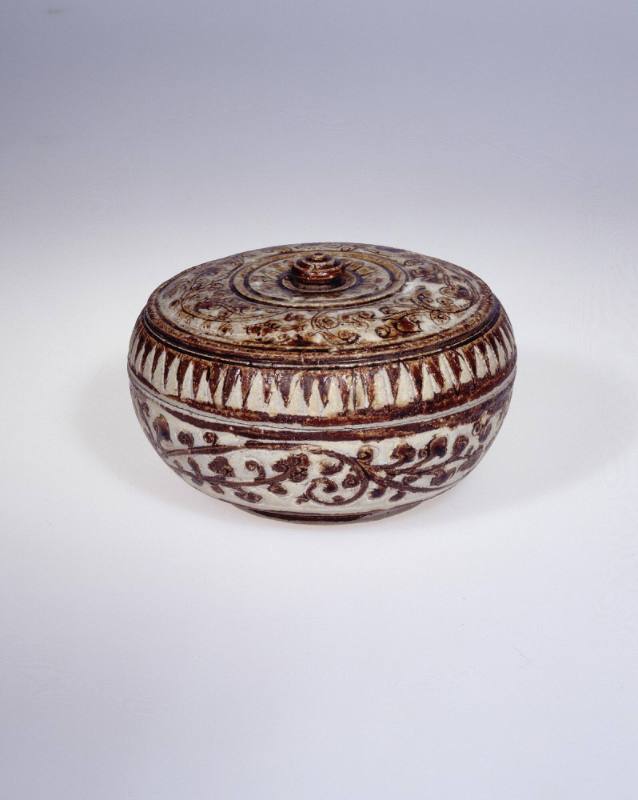
Object Details
Culture
Chorrera (Ecuador)
Date
1100–400 BCE
Medium
Earthenware
Dimensions
5 11/16 × 8 1/16 × 2 9/16 inches (14.4 × 20.5 × 6.5 cm)
Credit Line
Gift of Thomas Carroll, PhD 1951
Object
Number
2006.070.040
WHERE WAS IT MADE?This vessel was made in what is now Ecuador.HOW WAS IT MADE?The vessel’s two cha(…)
WHERE WAS IT MADE?This vessel was made in what is now Ecuador.HOW WAS IT MADE?The vessel’s two chambers were likely hand-built with the coil method. In this method, a base is made by shaping clay into a flat disc. Then hand formed coils of clay, like ropes, are successively added to one another, building up the walls of the vessel. A tool such as a wooden paddle is used to smooth the sides both inside and out, leaving no trace of the coils. The spout, handle and bird were made separately. The noisemaking character of whistle pots is an integral part of their function, and they are complicated to manufacture. Before the vessel was fired in an earthen pit, the surface was burnished using a smooth object such as a stone or piece of bone. Although this particular ceramic piece is made from a reddish-colored clay, it turned a grey-black color when it was fired.HOW WAS IT USED?This vessel functioned as a whistle pot. Whistle pots get their name from the sound they make when air is blown into them or when liquids move around inside them, for example from one side to another in the case of this double-chambered whistling pot. Whistling sounds are associated with rainfall and renewal – an important theme for agricultural people living in the barren desert of coastal Peru. The sounds produced by this whistle pot and other such instruments were used to open connections to the spirit world. Music served to invoke benign guardian spirits. After the Conquest, Europeans attempted to ban musical instruments such as flutes in order to suppress such contact with spirits. WHY DOES IT LOOK LIKE THIS? The form of the vessels could be based on the shape of a fruit or vegetable, possibly a pepper. Notice the bird on the top of one of the vessels. Birds are often symbolic of the spirit flight taken by a shaman or religious specialist during a vision quest, when the shaman is said to transform into a bird in order to transcend the material world and communicate with ancestor spirits. Often aided by hallucinogenic drugs, a shaman’s spirit would fly out from his body in search of knowledge and spiritual fulfillment. Birds of all sorts are commonly depicted on pre-Columbian works of art. Some birds, such as the harpy eagle, are said to “possess all the wisdom of the spirits.” Brightly-colored feathers were often added to clothing both for decoration and to symbolize shamanic transformation during vision quests and/or chiefly wisdom.ABOUT THE CHORRERA CULTURE:The Chorrera culture’s extended sphere of influence incorporated all three major Ecuadorian ecological zones: the coast, sierra (mountains), and Amazonia. While the Chorrera culture had its origins in the earlier Machalilla culture of the coast, certain aspects of its ceramic technology may have been influenced by the Ocós culture of Mesoamerica. The Chorrera people lived in small communities of 100-120 people, which seem to have supported craft specialists despite their small size. Fishing and farming were distinct occupations. The economy of the Chorrera people was based on farming, hunting and gathering. Trade along rivers and over the sea, especially trade in valuable stones such as lapiz lazuli, obsidian, and rock crystal, played an important role in the florescence of this culture. The highly burnished redware ceramics were decorated with black resist decoration, and feature an assortment of naturalistic animals and stylized human figures. Whistling bottles make their appearance during this period. The first cultural horizon in Ecuador to be widespread over a relatively large geographic region, the Chorrera people laid down a common cultural foundation upon which later cultures were built.












